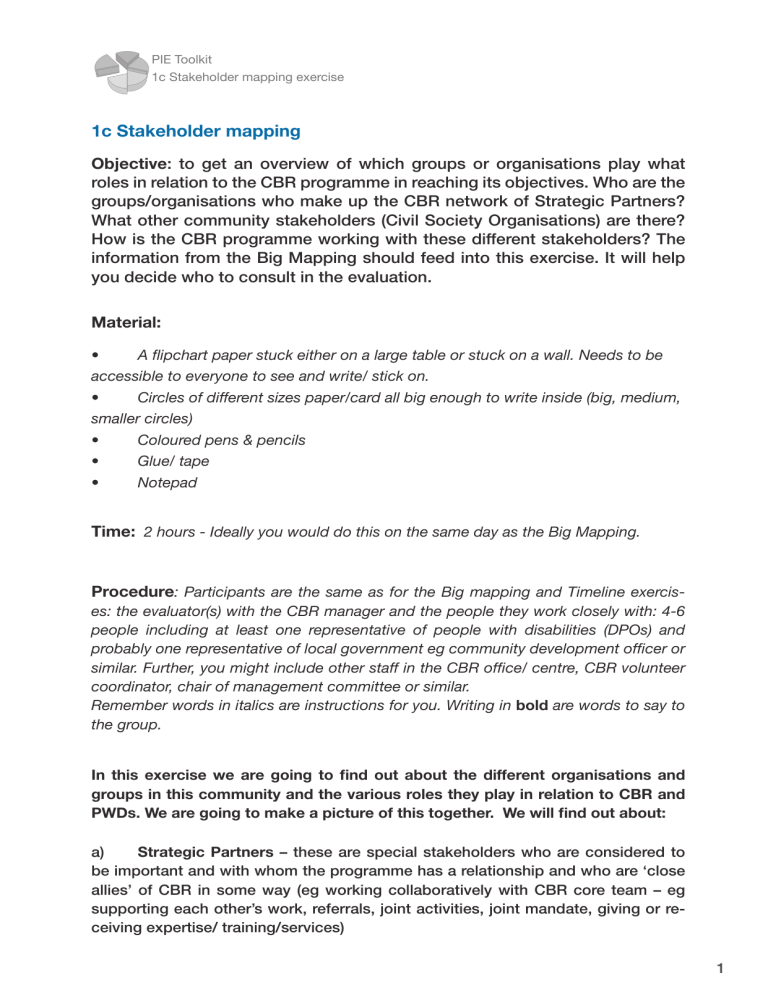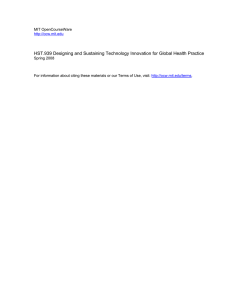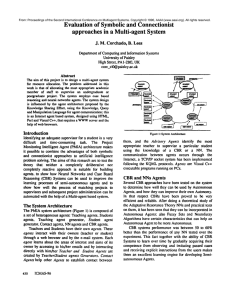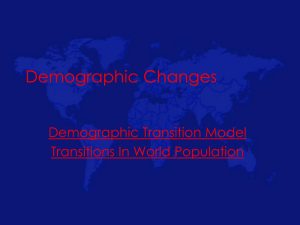1c Stakeholder mapping

PIE Toolkit
1c Stakeholder mapping exercise
1c Stakeholder mapping
Objective : to get an overview of which groups or organisations play what roles in relation to the CBR programme in reaching its objectives. Who are the groups/organisations who make up the CBR network of Strategic Partners?
What other community stakeholders (Civil Society Organisations) are there?
How is the CBR programme working with these different stakeholders? The information from the Big Mapping should feed into this exercise. It will help you decide who to consult in the evaluation.
Material:
•
•
•
• A flipchart paper stuck either on a large table or stuck on a wall. Needs to be accessible to everyone to see and write/ stick on.
• Circles of different sizes paper/card all big enough to write inside (big, medium, smaller circles)
Coloured pens & pencils
Glue/ tape
Notepad
Time:
2 hours - Ideally you would do this on the same day as the Big Mapping.
Procedure
: Participants are the same as for the Big mapping and Timeline exercises: the evaluator(s) with the CBR manager and the people they work closely with: 4-6 people including at least one representative of people with disabilities (DPOs) and probably one representative of local government eg community development officer or similar. Further, you might include other staff in the CBR office/ centre, CBR volunteer coordinator, chair of management committee or similar.
Remember words in italics are instructions for you. Writing in bold are words to say to the group.
In this exercise we are going to find out about the different organisations and groups in this community and the various roles they play in relation to CBR and
PWDs. We are going to make a picture of this together. We will find out about: a) Strategic Partners – these are special stakeholders who are considered to be important and with whom the programme has a relationship and who are ‘close allies’ of CBR in some way (eg working collaboratively with CBR core team – eg supporting each other’s work, referrals, joint activities, joint mandate, giving or receiving expertise/ training/services)
1
PIE Toolkit
1c Stakeholder mapping exercise b) Community Stakeholders (Civil Society Organisations) that are considered to be doing important work in the community (but not specifically related to CBR or disability issues – eg businesses, women’s groups, savings or loans groups, faithbased, special interest groups etc) c) The way the CBR Core team and different Strategic Partners work together
You should already have some names of organisations that play a key role in community development and improving the lives of people with disabilities from the Big Mapping exercise. On flip chart paper headed with the different CBR matrix components list all the organisations.
1. Let’s list all the organisations and groups that we mentioned in the Big
Mapping on this chart. We will put them under these different headings. Can we think of any more that were missed out earlier? Some might work under several of these headings.
Health Education Livelihoods Social Empowerment
2
(You can facilitate the group to come up with additional actors that were missed out before if necessary. Some may work across several components - you can list the same organisation more than once under different headings)
Next place 2 flipcharts together to make a double size one and write CBR programme in the middle. Using the different size circles ask the group:
2a. These circles will represent all the groups and organisations, how important they are and how they are linked. Which of this list of organizations/ networks/ groups are most important (play a big role now) in improving the lives of PWDs?
Write these names in the largest circles and colour code them according to their CBR component eg all the Health organisations with a blue dot, all the Livelihood organisations colour orange. Write a few words on the circle to show who they are and what sort of activities they are doing eg. Health Centre: child health clinic, prosthetics workshop or World Vision INGO: child welfare programmes which actively include disabled children.
PIE Toolkit
1c Stakeholder mapping exercise
Most important Moderate importance Low importance
Government
Health Centre
Treatment & diagnosis
INGO
Goat sharing scheme
Sports club
2b. Which organisations organizations/networks/groups do you consider to be of moderate importance in improving the lives of PWDs?
Write the names of these stakeholders in the medium size circles, again write inside the circle what activities they do and colour code them according to the matrix components.
2c. Now let’s check – are the ones we have left, those that only play a small role at the moment? Let’s put them on the smallest circles.
(same process – there may be some discussion – they need to reach a consensus)
3. Now you need to think about the relationship between these different stakeholders and the CBR Core team. We are thinking about all these organisations as making a kind of network or spiders web. So you need to position each of the stakeholders on the flipchart in relation to the CBR programme (which is in the centre).
The ones that the CBR programme works very closely with will be positioned near to the CBR programme. The ones that the CBR programme does not work with much or yet will be positioned far away from the CBR programme. Explain a large circle (important org), can still positioned far from the CBR programme (eg no 1). It might work on disability but not in a way that’s connected to the CBR programme (eg a private rehab centre or private special school with no connection with CBR)
CBR
3
4
PIE Toolkit
1c Stakeholder mapping exercise
4. Now we need to label how each Strategic Partner works with the Core Team and so contributes to the CBR/I programme.
Write this on the tag: eg referrals (in which direction?), joint meetings, training, funding source, information sharing, policy planning. A stakeholder can have more than one tag’
Community sports centr e
Training vocational skills Referral Centr e for the Deaf
CBR
Referral, awar school eness at primary eness Local artisans
Advocacy
, Awar
PIE Toolkit
1c Stakeholder mapping exercise
5. Now we can add in connections or relationships between different stakeholders. Apart from the CBR programme are there any other organisations that work closely together or work across components? Draw arrows between organisations that work closely together.
Community sports centr is now intr sive sports oducing inclu e
-
Training vocational skills Referral Centr e for the Deaf
CBR
, Awar
Advocacy
– str ong links with other CSOs
Referral, awar eness Local artisans war eness
5
6
PIE Toolkit
1c Stakeholder mapping exercise
6. Conclude the session by briefly reflecting about what the picture shows.
• What can we tell about the focus of the CBR programme in relation to different components of the matrix?
Probe: which seem to be main types of focus?
• Are there any community stakeholders that you consider important but that the programme is not working with closely yet? (ie they are not yet a strategic partner) Probe: What are reasons for this?
• What are the main labels you have given to the relationships?
• Are there any groups/organisations who are very active in disability work but not connected to others?
Probe: Working in isolation? Why is this?
7. Take a photo of the Stakeholder Map
8. The Stakeholder Map can be stuck on the wall and kept there during the evaluation. It can be referred to during other consultations and might get added to.
9. Thank everyone for their contributions



